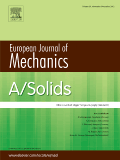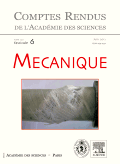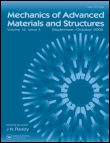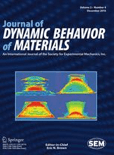
EUROPEAN JOURNAL OF MECHANICS A-SOLIDS
Scope & Guideline
Elevating Knowledge in Solid Mechanics
Introduction
Aims and Scopes
- Theoretical Mechanics:
The journal publishes papers that develop and apply theoretical frameworks for understanding the behavior of solid materials. This includes analytical models, continuum mechanics, and advanced mathematical techniques. - Experimental Mechanics:
A significant portion of the research focuses on experimental methods to validate theoretical predictions and explore material behavior under various loading conditions. This includes studies on mechanical testing, failure analysis, and material characterization. - Multiscale Modeling:
Research that integrates various scales, from atomic to macroscopic, is a core area. This includes studies that utilize computational techniques such as molecular dynamics and finite element analysis to understand complex material behaviors. - Innovative Materials:
The journal emphasizes the study of novel materials, including composites, metamaterials, and smart materials. Research on the mechanical properties and applications of these materials is a key focus. - Interdisciplinary Approaches:
Papers that bridge solid mechanics with other disciplines such as materials science, bioengineering, and nanotechnology are encouraged, reflecting the journal's commitment to advancing knowledge across fields.
Trending and Emerging
- Smart Materials and Structures:
Research into smart materials, including piezoelectric and shape-memory alloys, is on the rise. These materials offer unique properties that can be utilized in adaptive and responsive structural applications. - Multiphysics Coupling:
There is an increasing focus on studies that explore the coupling of mechanical, thermal, and electrical phenomena. This trend is particularly relevant in the context of energy harvesting and smart structural systems. - Additive Manufacturing and Material Design:
Papers investigating the mechanical properties and performance of materials produced through additive manufacturing techniques are becoming more prevalent, reflecting the growing interest in custom materials and structures. - Nonlinear Dynamics and Instability Analysis:
Research exploring nonlinear dynamic behaviors and stability issues in structures is trending, particularly under complex loading conditions. This reflects a move towards understanding real-world applications. - Machine Learning in Mechanics:
The integration of machine learning techniques for predictive modeling and data analysis in solid mechanics is emerging as a significant trend, indicating a shift towards data-driven approaches in the field.
Declining or Waning
- Traditional Material Testing Methods:
Research focusing solely on conventional material testing methods has declined. There is a growing preference for studies that integrate advanced techniques, modeling, and simulations. - Static Analysis of Simple Structures:
Papers concentrating on the static analysis of basic geometries and structures are waning, as the field increasingly values complex analyses that consider dynamic behavior, nonlinear effects, and real-world applications. - Classical Theories of Elasticity:
There is a noticeable decrease in research strictly adhering to classical elasticity theories without incorporating modern advancements. Researchers are now more inclined to explore nonlinear, viscoelastic, or time-dependent behaviors.
Similar Journals

Journal of Applied Mechanics and Technical Physics
Fostering Dialogue in the Heart of Technical PhysicsJournal of Applied Mechanics and Technical Physics is a distinguished publication that serves as a vital resource for researchers and professionals in the realms of mechanical engineering, mechanics of materials, and condensed matter physics. Published by MAIK NAUKA/INTERPERIODICA/SPRINGER, this journal has been committed to disseminating high-quality research since its inception in 1965. With a noted presence in the academic community, it holds a respectable Q3 ranking in multiple categories as of 2023, indicating its relevance and contribution to the field. Although it does not currently offer open access, the journal provides valuable insights and advancements through its rigorous peer-review process. Covering a broad spectrum of topics in applied mechanics and technical physics, it aims to foster innovation and dialogue among scientists, engineers, and scholars alike. Located in the United States, the journal continues to make significant strides in bridging the gap between theoretical research and practical applications, making it an essential read for anyone engaged in these dynamic fields.

COMPTES RENDUS MECANIQUE
Unveiling Innovations in Mechanics for a Global AudienceCOMPTES RENDUS MECANIQUE, an esteemed journal published by the Académie des Sciences, serves as a critical platform for cutting-edge research in the fields of mechanics and materials science. With an ISSN of 1631-0721 and an E-ISSN of 1873-7234, this open-access journal has gained visibility since its transition to open access in 2020, encouraging a broader dissemination of knowledge within the community. As of 2023, it holds a Q3 ranking in both the Materials Science (Miscellaneous) and Mechanics of Materials categories, according to category quartiles. Given its Scopus rankings—299th out of 398 in Mechanics of Materials and 360th out of 463 in General Materials Science—it provides valuable insights and advancements in these disciplines. Located in Paris, France, the journal caters to researchers, professionals, and students alike, showcasing a diverse range of studies and developments that push the boundaries of knowledge in mechanics. Through its accessible format, COMPTES RENDUS MECANIQUE not only highlights significant findings but also promotes collaboration and innovation across the global scientific community.

MECHANICS OF ADVANCED MATERIALS AND STRUCTURES
Transforming structural analysis through peer-reviewed excellence.Mechanics of Advanced Materials and Structures is a distinguished journal published by Taylor & Francis Inc, focusing on the innovative fields of Civil and Structural Engineering, Materials Science, Mechanical Engineering, and Mechanics of Materials. With ISSN 1537-6494 and E-ISSN 1537-6532, this journal is positioned within the Q2 quartile rankings of its categories, demonstrating its significant scholarly impact. It has been a pivotal platform since its inception in 1997, providing researchers and professionals with comprehensive insights and the latest findings, until the expected closure in 2024. Situated in the United Kingdom, the journal is dedicated to enhancing the understanding of complex materials and structural behavior through rigorous peer-reviewed articles. Its high visibility in Scopus rankings further underscores its importance, making it an essential resource for those engaged in advanced materials research and structural analysis. With options for open access, the journal ensures broad dissemination of knowledge, fostering a collaborative environment for researchers, practitioners, and students alike.

Journal of Dynamic Behavior of Materials
Advancing Research in Material MechanicsThe Journal of Dynamic Behavior of Materials, published by SpringerNature, serves as a premier platform for the dissemination of innovative research in the fields of materials science and mechanics of materials. With its ISSN 2199-7446 and E-ISSN 2199-7454, this international journal has established itself since its inception in 2015, showcasing groundbreaking insights into the dynamic properties and behaviors of various materials. Operating from Switzerland and headquartered in London, this journal embraces an open-access philosophy, albeit not entirely, to enhance research visibility. According to the Scopus rankings, it is positioned in the Q3 quartile for both materials science and mechanics of materials, indicating its growing prominence in the academic landscape. Researchers and professionals alike benefit from its wide-ranging contributions that address contemporary challenges and advancements, making it a critical resource for advancing knowledge and innovation in these crucial fields.

JOURNAL OF ELASTICITY
Pioneering Research in the Mechanics of MaterialsJOURNAL OF ELASTICITY is a prestigious peer-reviewed journal dedicated to the study and advancement of the field of elasticity and its numerous applications across various disciplines. Published by SPRINGER, and located in the Netherlands, this journal has been a key resource since its inception in 1971, providing critical insights and developments up through 2024. With a commendable impact factor and categorized within the Q2 quartile in areas such as Materials Science, Mechanical Engineering, and Mechanics of Materials, the journal maintains a significant standing in the academic community. Researchers and professionals will find a wealth of knowledge through advanced theoretical and experimental studies published within its pages, contributing to both foundational understanding and practical applications. While currently not an open access publication, the JOURNAL OF ELASTICITY remains an essential platform for innovative research and discussions that shape the future of mechanical sciences.

Materials Physics and Mechanics
Unraveling the Complexities of Condensed MatterMaterials Physics and Mechanics is a pivotal journal dedicated to advancing the fields of condensed matter physics, materials science, mechanical engineering, and the mechanics of materials. Published by the Institute of Problems in Mechanical Engineering, Russian Academy of Sciences, this journal has established itself as a valuable resource since its inception, particularly from 2003 to 2004 and now continuously from 2009 to 2024. Although it currently holds a Q4 categorization in various disciplines, its contributions are critical to understanding and developing new materials and their applications in engineering. The journal provides insightful articles that explore the nuances of material properties, their behaviors under different conditions, and the physical principles governing these phenomena. Though it operates under a traditional publication model, the insights provided within its pages are invaluable to researchers, professionals, and students striving to push the boundaries of knowledge in the materials domain. Its ISSN numbers (1605-2730, E-ISSN 1605-8119) serve as a gateway to a wealth of scientific knowledge emanating from the Russian Federation, contributing to the global discourse in materials physics and mechanics.

MECHANICS RESEARCH COMMUNICATIONS
Unveiling Insights in Mechanical Engineering ExcellenceMECHANICS RESEARCH COMMUNICATIONS, published by PERGAMON-ELSEVIER SCIENCE LTD, is a prestigious journal in the fields of Civil and Structural Engineering, Condensed Matter Physics, Materials Science, and Mechanical Engineering. With an ISSN of 0093-6413 and E-ISSN of 1873-3972, it has made significant contributions to the understanding and advancement of mechanics and materials since its inception in 1974. The journal is well-regarded in academia, holding a Q2 ranking across multiple categories as of 2023, and ranking in the 65th percentile for Mechanical Engineering. Researchers and professionals benefit from its peer-reviewed content, which includes a wide range of articles from fundamental research to applied technological developments. Although currently not an open access journal, it remains a vital resource for those focused on innovating within the engineering and materials science domains. With its established legacy, MECHANICS RESEARCH COMMUNICATIONS continues to shape the discourse in mechanics and engineering, making it essential reading for students and practitioners alike.

Journal of Mechanics of Materials and Structures
Pioneering Developments in Mechanics of Materials and Structures.Journal of Mechanics of Materials and Structures, published by Mathematical Science Publishers, is a distinguished periodical in the field of Applied Mathematics and Mechanics of Materials. With the ISSN 1559-3959, this journal has been a pivotal platform since its inception in 2006, providing insights and advancements in the mechanics of materials and their structural applications. Operating out of the University of California, Berkeley, this journal not only boasts a respectable standing within its categories, ranking Q4 in Applied Mathematics and Q3 in Mechanics of Materials as of 2023, but it also serves a crucial role in fostering academic discourse among researchers, practitioners, and students alike. Although it does not currently offer open access, its contributions to the respective fields are invaluable, underscoring the relevance and importance of continued research in understanding material behavior and structural integrity. Whether investigating theoretical frameworks or engineering applications, the Journal of Mechanics of Materials and Structures remains an essential resource for anyone dedicated to the advancement of the science of materials and structures.

International Journal of Mechanics and Materials in Design
Transforming Ideas into Engineering ExcellenceInternational Journal of Mechanics and Materials in Design is a leading publication in the field of mechanical engineering and materials science, published by Springer Heidelberg. With an impressive impact factor, it holds esteemed rankings as Q1 in both Mechanical Engineering and Mechanics of Materials, and Q2 in Materials Science for the year 2023, solidifying its reputation as a significant contributor to the advancement of design methodologies. The journal focuses on the intersection of mechanics and materials, encouraging innovative research that addresses contemporary challenges faced in engineering disciplines. Researchers and professionals alike can benefit from accessing cutting-edge studies contributing to various applications, making it an invaluable resource for staying informed in this dynamic field. While the journal operates under a subscription model, its comprehensive reviews and high-quality original research foster a deeper understanding of material behavior and design principles, thus supporting the academic growth and professional development of its readers.

ARCHIVES OF MECHANICS
Unleashing Innovation in Mechanical Engineering and Materials ScienceArchives of Mechanics, published by the Polish Academy of Sciences Institute of Fundamental Technological Research, is a distinguished open-access journal established in 1971 that has played a pivotal role in the dissemination of knowledge in the fields of Mechanical Engineering and Condensed Matter Physics. With its commitment to accessibility since adopting open access in 2022, this journal provides a platform for researchers, professionals, and students to share cutting-edge research findings and innovative methodologies. Although it currently holds a Q4 ranking in Condensed Matter Physics and a Q3 ranking in Mechanical Engineering for 2023, its comprehensive scope, which spans critical advancements in mechanical systems and materials science, positions it as a valuable resource for the academic community. Located in Warsaw, Poland, the journal continues to contribute significantly to the global discourse on mechanics and is dedicated to fostering new ideas that advance both theoretical and applied aspects of the discipline.